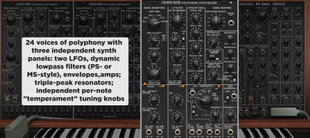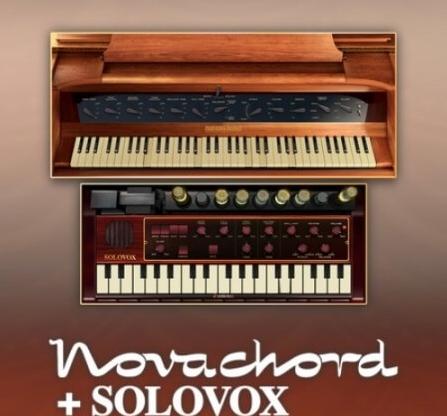Cherry Audio PS-3300 v1.0.4.54 WiN
Soft / VST Instruments / VST Effects / VST Plugins
16-10-2023

PS-3300 is an exactingly faithful virtual analog emulation of the colossal and ultra-rare semi-modular analog polyphonic synthesizer released by KORG in 1977. Cherry Audio has pulled out all the stops to accurately recreate and update this mythical monster synth, from its massive stacked sonic character and signature multiple‑resonator sweeps to the considerable patching capabilities that distinguished the PS-3300 from all other polysynths of the era.
Big in Japan... and everywhere else
Before releasing its renowned line of MS monosynths, Keio Electronic Laboratories (under the KORG brand name) introduced its Polyphonic Series of analog synthesizers. The largest and most expensive was the massive PS-3300, a legendary synthesizer produced between 1977 and 1981. It is widely considered one of the most rare analog synthesizers ever made, with around 50 units produced. With its semi-modular design, flexible architecture, and a propensity for rich, sonically evolving timbres, the PS-3300 is often regarded as the holy grail of polyphonic analog synths.
PS-3300's unique architecture set it apart from the handful of polysynths available at the time. It had three independent "signal generator" panels, each essentially a complete polyphonic synthesizer. Each of these synth panels included 12 independently tunable divide-down oscillator banks as well as independent discrete VCFs, envelope generators, and VCAs for every note. This enabled all 48 keys of the external keyboard to be simultaneously played with independent articulation. Dual LFOs and triple voltage‑controllable resonators for each generator further shaped its signature tone. A dedicated master panel featured a mixer with VCAs for each of the three voice panels, sample & hold, an additional envelope generator, and two control voltage processors. It also delivered extensive modulation possibilities through an astounding 67 front-panel input/output jacks. Taken as a whole, the PS-3300 was so powerful and revolutionary that even Bob Moog was impressed, stating that it was, "the best synthesizer for fat sounds."
The PS-3300's high production cost meant that only the wealthiest musicians could afford it, thus adding to its rarity and mystique. Its broad and bold sound, described as an orchestra of synthesizers, has made it a highly sought-after instrument by professional musicians and collectors alike. Its adoption by groundbreaking artists such as Vangelis, Jean-Michel Jarre, Aphex Twin, Kraftwerk, Klaus Schulze, Keith Emerson, and Space has further bolstered its popularity over the decades. Korg introduced the PS-3300 at $7,500 in 1977, and it is now so rare and coveted that one sold for nearly $100,000 in 2021!
PS-3300 Features
Exactingly faithful virtual analog emulation of the semi-modular analog polyphonic synthesizer released by Korg in 1977
Three independent "signal generator" panels, each with an oscillator, lowpass filter, three-peak resonators, envelope with velocity, amp, two mod generator LFOs, and per-note tuning:
3X VCOs with six waveforms: triangle, saw, rectangle (square), two preset pulse waves (with different widths), and PWM (variable-width pulse)
3X resonant VCF 12 dB/oct lowpass filters with the option to select between the standard "clean" PS filter or the "crunchier" MS-style filter
3X modulatable "triple resonators": 12 dB/oct bandpass filters to produce vowel and phasing tones
3X discreet ADSR-type envelope modulators with velocity control, and amplitude modulation
3X two syncable "mod generators" (LFOs) with output jacks: one with triangle, saw, ramp, rectangle, pink noise, and white noise, and the other with triangle waveform
3X temperament section with individual tuning knobs for the 12 chromatic notes, and temperament presets for Equal Tempered, Mean Tone System, Hepatonal System, and Just Intonation
Copy/paste settings from one signal generator panel to another
Polyphonic mode with up to 24 voices of polyphony and three monophonic modes: last, low, and high note priority
Semi-modular synthesizer with virtual jack and cable system, featuring unlimited mults per jack and customizable (color, transparency, animation) cables
Master signal mixer panel with sample & hold, general envelope generator, and two control voltage (CV) processors
Individual channel panning
User-selectable bend range and master tune
Studio-quality integrated effects: chorus, echo with sync, and three types of reverb (spring, plate, and Galactic)
Over 360 professionally designed presets in a dozen categories. These include a bonus Legacy collection of basic presets based on the patch sheets in the original PS-3300 Owner's Manual, a 3100-based Glissando patch, and a 432 Hz Equal Temperament patch, all to get your started in your own sound design adventures.
Standalone virtual instrument and plug-in versions
Complete MIDI control and DAW automation for all controls, with easy-to-use MIDI Learn and mapping
Cherry Audio's popular Focus zoom-in feature, as well as standard UI zoom and resize via drag
Complete documentation available directly online from the instrument or in downloadable PDF format
User-adjustable oversampling control
home page:
https://goo.su/sH9L
Big in Japan... and everywhere else
Before releasing its renowned line of MS monosynths, Keio Electronic Laboratories (under the KORG brand name) introduced its Polyphonic Series of analog synthesizers. The largest and most expensive was the massive PS-3300, a legendary synthesizer produced between 1977 and 1981. It is widely considered one of the most rare analog synthesizers ever made, with around 50 units produced. With its semi-modular design, flexible architecture, and a propensity for rich, sonically evolving timbres, the PS-3300 is often regarded as the holy grail of polyphonic analog synths.
PS-3300's unique architecture set it apart from the handful of polysynths available at the time. It had three independent "signal generator" panels, each essentially a complete polyphonic synthesizer. Each of these synth panels included 12 independently tunable divide-down oscillator banks as well as independent discrete VCFs, envelope generators, and VCAs for every note. This enabled all 48 keys of the external keyboard to be simultaneously played with independent articulation. Dual LFOs and triple voltage‑controllable resonators for each generator further shaped its signature tone. A dedicated master panel featured a mixer with VCAs for each of the three voice panels, sample & hold, an additional envelope generator, and two control voltage processors. It also delivered extensive modulation possibilities through an astounding 67 front-panel input/output jacks. Taken as a whole, the PS-3300 was so powerful and revolutionary that even Bob Moog was impressed, stating that it was, "the best synthesizer for fat sounds."
The PS-3300's high production cost meant that only the wealthiest musicians could afford it, thus adding to its rarity and mystique. Its broad and bold sound, described as an orchestra of synthesizers, has made it a highly sought-after instrument by professional musicians and collectors alike. Its adoption by groundbreaking artists such as Vangelis, Jean-Michel Jarre, Aphex Twin, Kraftwerk, Klaus Schulze, Keith Emerson, and Space has further bolstered its popularity over the decades. Korg introduced the PS-3300 at $7,500 in 1977, and it is now so rare and coveted that one sold for nearly $100,000 in 2021!
PS-3300 Features
Exactingly faithful virtual analog emulation of the semi-modular analog polyphonic synthesizer released by Korg in 1977
Three independent "signal generator" panels, each with an oscillator, lowpass filter, three-peak resonators, envelope with velocity, amp, two mod generator LFOs, and per-note tuning:
3X VCOs with six waveforms: triangle, saw, rectangle (square), two preset pulse waves (with different widths), and PWM (variable-width pulse)
3X resonant VCF 12 dB/oct lowpass filters with the option to select between the standard "clean" PS filter or the "crunchier" MS-style filter
3X modulatable "triple resonators": 12 dB/oct bandpass filters to produce vowel and phasing tones
3X discreet ADSR-type envelope modulators with velocity control, and amplitude modulation
3X two syncable "mod generators" (LFOs) with output jacks: one with triangle, saw, ramp, rectangle, pink noise, and white noise, and the other with triangle waveform
3X temperament section with individual tuning knobs for the 12 chromatic notes, and temperament presets for Equal Tempered, Mean Tone System, Hepatonal System, and Just Intonation
Copy/paste settings from one signal generator panel to another
Polyphonic mode with up to 24 voices of polyphony and three monophonic modes: last, low, and high note priority
Semi-modular synthesizer with virtual jack and cable system, featuring unlimited mults per jack and customizable (color, transparency, animation) cables
Master signal mixer panel with sample & hold, general envelope generator, and two control voltage (CV) processors
Individual channel panning
User-selectable bend range and master tune
Studio-quality integrated effects: chorus, echo with sync, and three types of reverb (spring, plate, and Galactic)
Over 360 professionally designed presets in a dozen categories. These include a bonus Legacy collection of basic presets based on the patch sheets in the original PS-3300 Owner's Manual, a 3100-based Glissando patch, and a 432 Hz Equal Temperament patch, all to get your started in your own sound design adventures.
Standalone virtual instrument and plug-in versions
Complete MIDI control and DAW automation for all controls, with easy-to-use MIDI Learn and mapping
Cherry Audio's popular Focus zoom-in feature, as well as standard UI zoom and resize via drag
Complete documentation available directly online from the instrument or in downloadable PDF format
User-adjustable oversampling control
home page:
https://goo.su/sH9L
Related articles
 Cherry Audio Solovox v1.0.3.21 WiN
Cherry Audio Solovox v1.0.3.21 WiN
Soft / VST Instruments / VST Effects
12-07-2023
The Solovox, manufactured by Hammond between 1940 and 1950, was another classic instrument of the era. Based on the Novachord’s oscillator and divider circuits, the Solovox with its 18 vacuum tubes was a small monophonic keyboard instrument attached beneath a piano keyboard and intended to augment it with organ-type lead voices. It consisted of two units: the three-octave mini keyboard, and a tone cabinet for the electronic sound generator, amplifier, and loudspeaker. Like the Clavioline and Ondioline, the Solovox produced a range of string, woodwind, and organ sounds and was widely used in light music from the 1940s and into the 1960s. Unfortunately, the introduction of compact transistor organs released in the 60s marked the end of the Solovox’s popularity.
VST Effects / VST Plugins / Audio Soft
11-03-2023
The Sleeper Has Awakened
Mercury-6 is a meticulous recreation of the Jupiter-6 analog synthesizer, just in time for its 40th anniversary! Sandwiched between the earlier Jupiter-4 and Jupiter-8 models in name only, the sophisticated Jupiter-6 has sometimes been considered a sleeper release.
These days, it has persevered to become one of Roland's most notable and coveted classic synthesizers due to its distinctive dark and complex character. Mercury-6 captures all that is exceptional in this treasured polyphonic classic, boosts its extraordinary feature set for today's DAW production and workflow, and celebrates the ground-breaking innovation from the era that changed music forever.
VST Effects / VST Plugins
18-04-2022
PS-20 is an ultra-realistic, polyphonic, hot-rodded tribute to Korg's renowned MS-20. First and foremost, PS-20's dual highpass/lowpass filters super accurately recreate the MS-20's famous raunchy sound in all of its squelchy, screaming glory. In addition to its unique filters, the MS-20’s other signature feature is its modular-style patch panel. We’ve reconfigured the patch panel from the original instrument, adding many desired in and out patch points for all oscillators, filters, and VCAs, correcting the confusing terminology of the original, and throwing in a few extras that greatly expand its usability.
Soft / Samples, Presets, Banks Of Sounds
9-02-2022
Max for Cats’ latest creation brings the versatility of a semi-modular interface to the world of analog-modelling synthesis. Built around a flexible virtual patchbay, Pallas gives users immense control over a wide range of bold and unique sounds.
Pallas is a Max for Live device that has been specifically designed to model all the grit, character, and charm of authentic analog sounds. Featuring eight-voice polyphony, Pallas is powered by three versatile oscillators. The device's main two oscillators allow users to mix up to four waveforms (sine, triangle, square, and sawtooth, and an additional noise generator), while the third oscillator is a wavetable-based signal generator that can also be used as an additional LFO for modulation purposes.